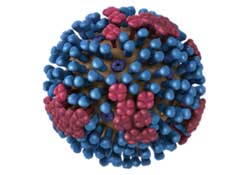New research shows low absolute humidity drives flu outbreaks
April 2010 | Volume 9, Issue 2

Illustration by Dan Higgins, CDC
The ultrastructure of influenza virion.
The annual spike in winter influenza epidemics has been traced to low absolute humidity, which creates environmental conditions that support the virus' survival and spread. The study was conducted by Fogarty grantee and climatologist Dr. Jeffrey Shaman and collaborators that included Fogarty scientist Dr. Cecile Viboud. Their findings were recently published in PLoS Biology.
This discovery discredits theories that the flu is strongest during cold weather because people cocoon indoors, get less fresh air and exercise, or have generally weakened immune systems. The researchers say that although a natural reaction to this study may be running a humidifier all winter, vaccination remains the best defense against the flu.
The effects of temperature, solar radiation, the school calendar and other potential influences were also examined but the data indicate that absolute humidity alone is sufficient to explain observed seasonal variations of influenza transmission in temperate regions.
Absolute humidity is the quantity of water vapor in a particular volume of air, regardless of the temperature. This is not to be confused with relative humidity, which is temperature-dependent.
Most indoor environments are temperature controlled, but indoor absolute humidity levels fluctuate as outdoor absolute humidity levels change.
“In some areas of the country, a typical summer day can have four times as much water vapor as a typical winter day - a difference that exists both indoors and outdoors,” says Shaman, a professor at Oregon State.
For this study, Shaman and his colleagues extended their previous findings on absolute humidity and influenza from the laboratory to the human population. They compiled flu onset dates from 30 winters and found periods of low absolute humidity preceded 55-60 percent of the outbreaks.
The roots of seasonal flu patterns are of basic scientific interest and public health importance. The association of low absolute humidity with the onset of outbreaks, which have significant annual variation, suggests that accurate and timely forecasts of approaching flu epidemics could be developed. Being forewarned could potentially aid public health planning and intervention strategies.
More Information
To view Adobe PDF files,
download current, free accessible plug-ins from Adobe's website.